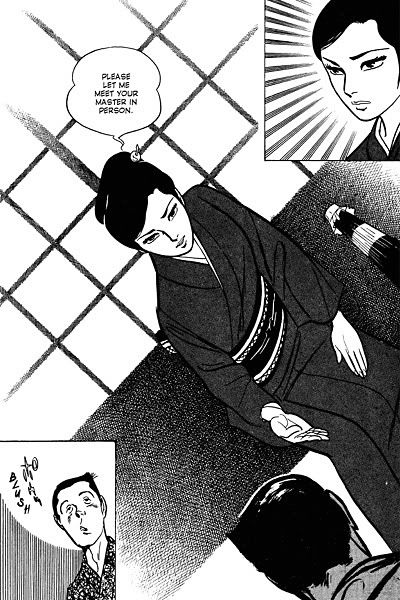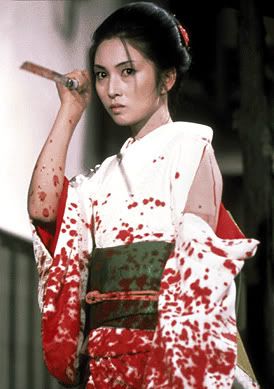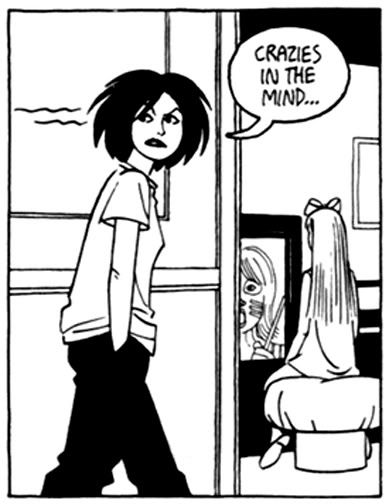 Lady Snowblood Vol. 1: The Deep-Seated Grudge Pt. 1
Lady Snowblood Vol. 1: The Deep-Seated Grudge Pt. 1Publisher: Dark Horse
Written by: Koike Kazuo
Art by: Kamimura Kazuo
Translation: Naomi Kokubo
Capsule review: If this wasn't on Quentin Tarantino's "List of Cool Stuff I'm Gonna Rip-Off For Kill Bill," then I'll eat... some delicious sashimi or unagi. Koike Kazuo's other great character (after Itto Ogami), Yuki is a killer as cold as the frozen stuff that is her namesake and her stories are wicked.
The rickshaw shop owner is a scummy guy, no doubt. Nasty through and through. His business acumen includes doing things like having his jinriksha runners kidnap women customers and sell them into prostitution. But when his crew’s latest victim- a dirty-faced naïf obsessed with painting- shows him her portfolio and explains her dream is to paint lovely pictures on the sides of jinriksha, the man is excited, wowed even.
What a great idea! His boys will clean up, because who wouldn’t want to ride in a moveable work of art? And the yen begins to flow like a rising tide of money. Until the police show up and let everyone in on a little seditious secret they’ve discovered. As the shop owner and his criminal allies are led away in chains to their deaths, the stunned guy looks around for his lovely little artist.
The girl from the sticks, with the innocent, smudged face; where is she? Why, she’s off killing again, endlessly pursuing her mother’s revenge from beyond the grave. A string of blood to which she’s tethered by the bitter circumstances of her birth. The way she takes down the rickshaw shop owner is actually pretty tame compared to the havoc she wreaks elsewhere.
Welcome to the world of Yuki, known professionally as Lady Snowblood. For the outrageous sum of 10,000 yen, she’ll kill for you, no matter how difficult the target. Koike Kazuo’s lethal assassin has a face as beautifully tranquil as a haiku and a slender blade concealed in her umbrella. When she unsheathes it, blood flies like red rain.
 One thing I really love about this book is the dichotomy between the brutal stories and their poetic titles. My favorites are “Stylish Woman and Umbrella Over Rain of Blood” and “Dead Cherry Blossoms and the Dance of Short Sleeve with White Blade.” Thanks to artist Kamimura Kazuo there are also moments of cinematic beauty. Falling snow is a recurring visual motif. In fact, the book begins with Lady Snowblood making her way through a winter cityscape. It's very pretty, but this book isn't called Lady Snowblood's Old Tokyo Walking Tour Vol. 1: The Long-Awaited Snowfall Pt. 1.
One thing I really love about this book is the dichotomy between the brutal stories and their poetic titles. My favorites are “Stylish Woman and Umbrella Over Rain of Blood” and “Dead Cherry Blossoms and the Dance of Short Sleeve with White Blade.” Thanks to artist Kamimura Kazuo there are also moments of cinematic beauty. Falling snow is a recurring visual motif. In fact, the book begins with Lady Snowblood making her way through a winter cityscape. It's very pretty, but this book isn't called Lady Snowblood's Old Tokyo Walking Tour Vol. 1: The Long-Awaited Snowfall Pt. 1.Fortunately, Kamimura doesn’t shy away from depicting gore and the stories give him ample opportunities to do so; another frequent motif is blood spattered on Lady Snowblood’s naked ivory skin. However, Kamimura’s figure work is more angular and somewhat stiffer than Koike’s Lone Wolf collaborator Kojima Goseki and his crosshatching is so straight-ruled and machine-like it does little to loosen things up. On the other hand, he’s no less adept than Kojima at pacing and panel-to-panel transitions. These make the reader feel more like he or she is watching a film than reading a comic. But where Kamimura excels is in the action shots, especially when depicting movement. Most impressive is the panel in "Sumida River Loincloth Cutting Board" where Kamimura uses the traditional Japanese comics "speedlines" to produce a startling image- a buck naked Lady Snowblood takes out three thugs with more rushing at her, an entire bloodletting sequence compressed into a single drawing.
 The ongoing plot is somewhat similar to Lone Wolf. Like Itto Ogami, Lady Snowblood pursues vengeance and hews to a personal sense of honor and justice. And like the samurai, she kills for money, accepting the jobs without judgment in an amoral way that renders her at least somewhat sympathetic compared outright immoral enemies she frequently faces. Koike also weaves real world figures into the tapestry with his fictional creations, and makes clever use of actual historical incidents in this well-researched series. And he makes sure the reader understands Lady Snowblood’s Japan is a wicked place; innocent people are few and far between and the assassin’s allies and clients are also pretty shady, and frequently criminal themselves. She tangles with gamblers who think nothing of using rape as a punishment for cheating, and even the government cannot be trusted as we discover when Lady Snowblood infiltrates a secret pleasure palace and stains the flowered gardens red.
The ongoing plot is somewhat similar to Lone Wolf. Like Itto Ogami, Lady Snowblood pursues vengeance and hews to a personal sense of honor and justice. And like the samurai, she kills for money, accepting the jobs without judgment in an amoral way that renders her at least somewhat sympathetic compared outright immoral enemies she frequently faces. Koike also weaves real world figures into the tapestry with his fictional creations, and makes clever use of actual historical incidents in this well-researched series. And he makes sure the reader understands Lady Snowblood’s Japan is a wicked place; innocent people are few and far between and the assassin’s allies and clients are also pretty shady, and frequently criminal themselves. She tangles with gamblers who think nothing of using rape as a punishment for cheating, and even the government cannot be trusted as we discover when Lady Snowblood infiltrates a secret pleasure palace and stains the flowered gardens red.White Kimono with Crimsom Flowers: the cinematic Lady Snowblood, as personified by Kaji Meiko.
In another similarity to Kazuo’s more celebrated creations Lone Wolf and Cub, Lady Snowblood inspired a movie series… and was an obvious progenitor for Quentin Tarantino’s the Bride and her enemy O-Ren Ishii; I mean, it’s no accident their climactic katana duel plays out in a pristine snowy environment with one woman dressed in a kimono and probably even less of one that Dark Horse’s graphic designers copied Kill Bill’s yellow-and-black ultra-bold typeface look for the Lady Snowblood comics covers.
 Look familiar? Kaji Meiko even sings on the soundtrack!And again Dark Horse relies on Naomi Kokubo (with help from Jeff Carlson) for the translation. Compared to the work in the Ito Junji volumes, the dialogue here is fairly formalized, except when expressed by the low-class underworld denizens Lady Snowblood spends so much time killing. And yet since this is a period piece, it makes perfect sense. Again, excellent work. The people in charge of Dark Horse’s Japanese comics really seem to know what they’re doing, and the end results reflect a level of care and respect for the material. This is vital when you’re dealing with a top-flight writer like Koike Kazuo- he’s one of the top comics writers in the world, bar none.
Look familiar? Kaji Meiko even sings on the soundtrack!And again Dark Horse relies on Naomi Kokubo (with help from Jeff Carlson) for the translation. Compared to the work in the Ito Junji volumes, the dialogue here is fairly formalized, except when expressed by the low-class underworld denizens Lady Snowblood spends so much time killing. And yet since this is a period piece, it makes perfect sense. Again, excellent work. The people in charge of Dark Horse’s Japanese comics really seem to know what they’re doing, and the end results reflect a level of care and respect for the material. This is vital when you’re dealing with a top-flight writer like Koike Kazuo- he’s one of the top comics writers in the world, bar none.Mmm... this is the good stuff!


